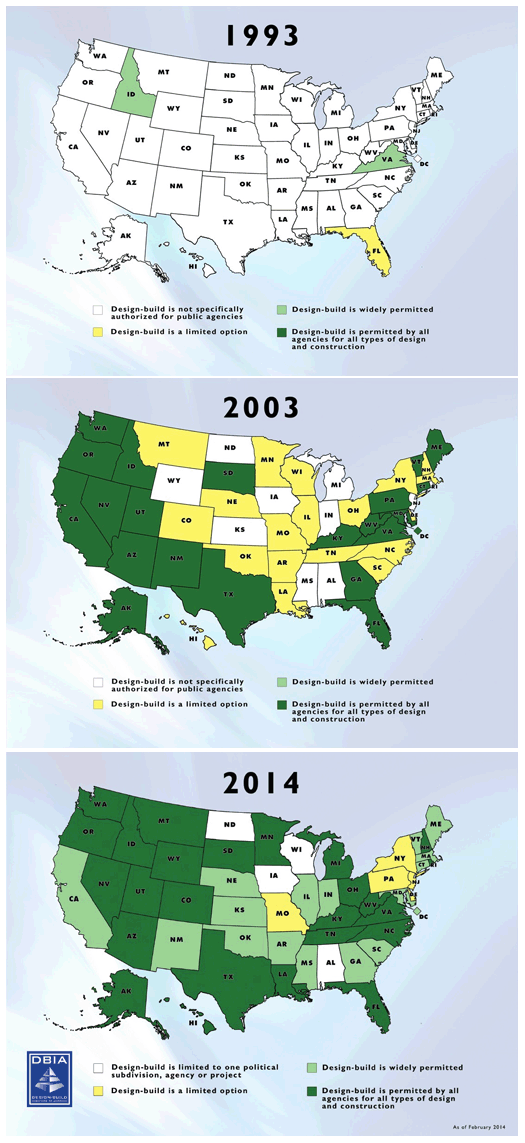by Geoff Corey | April 16, 2014
Every day DBIA works with architects, engineers, contractors and owners who are experts and innovators in design-build project delivery. Industry leaders have worked with DBIA to advocate for, not just design-build, but Design-Build Done Right. When delivered correctly, design-build leads to some of the highest quality projects in the country, which is why DBIA has worked with these partners to educate lawmakers, private and public owners, and the entire A/E/C industry on the best ways to achieve that kind of success. A behind-the-scenes look will reveal that DBIA’s efforts to define, teach and promote best practices in design-build are just as integrated as design-build itself.
Making it Possible
If design-build is not legally authorized, of course, it cannot happen. DBIA was founded in 1993 by senior executives of various companies using design-build with a firm focus on expanding design-build authorization in the U.S. The maps below demonstrate the great progress we’ve made on the state level, and our federal advocacy has seen similar success.
Today, design-build is authorized for public projects in some form in 95 percent of U.S. states and a majority of states permit all public agencies to use design-build for all types of design and construction. Last year alone, there were 99 bills introduced that affected the design-build industry. We were active on these bills and achieved a favorable outcome 68 percent of the time; a great legislative track record.
Teaching Best Practices
Passing legislation to authorize design-build, while essential, is just the beginning of the Design-Build Done Right process. Once a state authorizes the delivery method, DBIA’s Education and Certification team enters the region, organizing workshops and classes in strategic locations to help practitioners and owners learn how to implement DBIA Best Practices on upcoming design-build projects. Potential design-builders in these states seek to become experts in Design-Build Done Right by attending DBIA conferences, becoming DBIA members and attaining DBIA Certification as a Designated Design-Build Professional.
 These efforts are why the recently published universal DBIA Best Practices are so important. Based on research, case studies and extensive industry input for more than a year, DBIA has identified the design-build best practices and implementing techniques that directly impact project performance. We then distribute this document in areas just beginning to use design-build for the first time. We released DBIA Best Practices just this month, focusing on 10 best practices and over 50 implementing techniques.
These efforts are why the recently published universal DBIA Best Practices are so important. Based on research, case studies and extensive industry input for more than a year, DBIA has identified the design-build best practices and implementing techniques that directly impact project performance. We then distribute this document in areas just beginning to use design-build for the first time. We released DBIA Best Practices just this month, focusing on 10 best practices and over 50 implementing techniques.
“The 10 Design-Build Done Right Best Practices serve as a single source that clearly defines design-build fundamentals to significantly enhance superior project outcomes,” said Lisa Washington, CAE, Executive Director and CEO of DBIA. “With design-build currently at 40 percent of all non-residential design and construction, the impetus for owners to engage in Design-Build Done Right is at an all-time high. By applying these 10 DBIA Best Practices, owners and practitioners will unlock the inherent value of design-build project delivery.”
Celebrating Design-Build Done Right
Great projects are a success for our industry and the country as a whole. When high-quality infrastructure is delivered in less time, with fewer change orders, and with enhanced innovation, design-build project delivery becomes a mainstream success story. Those who successfully implement DBIA Best Practices are often rewarded with great recognition, includinga Design-Build Project/Team Award. Past award winners include the Colorado T-Rex Project, the Minnesota I-35W bridge replacement, the UC Irvine Contemporary Arts Center, and the MetLife Stadium where the 2014 Super Bowl was held.
And we are not done yet. DBIA recognizes that there are real-world differences among design-build market sectors (e.g., water/wastewater, transportation, federal projects), and that specific implementation techniques might differ slightly from one market sector to another. For this reason, DBIA is in the process of working with market sector experts on sector-specific documents to supplement the overall DBIA Best Practices document. These will provide more detailed guidance on how to put these best practices and implementing techniques into use in different design-build market sectors.
Thanks to DBIA’s Board of Directors, market-sector committees, and various volunteers and industry leaders, more and more owners and practitioners are following DBIA Best Practices and achieving Design-Build Done Right. Your input, suggestions and comments as we drill down to create market-sector-specific best practices are always welcome.

